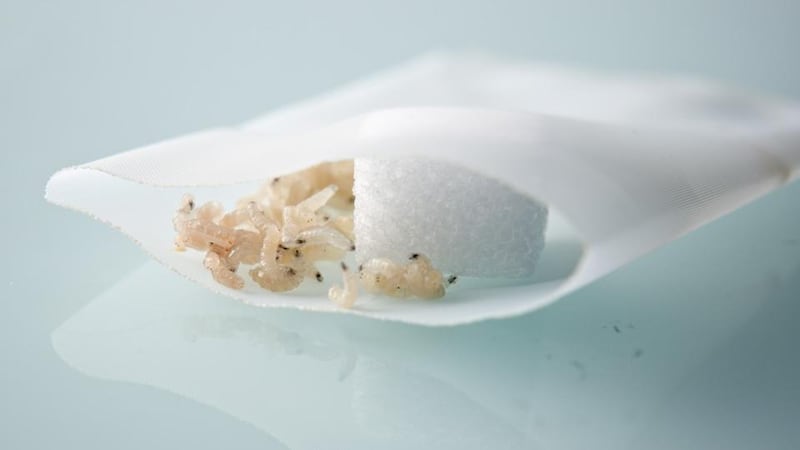So you thought modern medicine was all pills and potions? Inhalers and injections? Think again – maggots, leeches and the use of silver and honey are all in a day’s work in Irish hospitals and community care now.
The first leech was apparently used in medicine about 1000BC. We import about 2,000 leeches per year at a cost of around €10 each. They are used in some of our larger hospitals in operations where there’s a need to keep blood flowing in order that small blood vessels can repair without the blood clotting. Leeches are also useful in relieving a patient of congested blood.
The southern European leech used, hiruda verbana , is imported from Biopharm in Wales, which describes itself as being at "the biting edge of science". At any one time the company has 30,000-70,000 leeches being reared for use.

The leech has approximately 100 teeth and three jaws, meaning that a leech bite consists of roughly 30 teeth. Thankfully the leech administers its own anaesthetic as it bites and its triple-jaw arrangement means that its bite results in a neat cut.
Bleed steadily
Even after the leech has finished feeding and drops off, its work continues. It secretes several compounds into the wound while it feeds and it is these which ensure that the site continues to bleed steadily for up to 10 hours.
One of these is hirudin, an anti-thrombin. Another is calin which is responsible for prolonging the bleeding. This all gives time for a body part to re-establish its own circulation.
June O’Shea, chief pharmacist at St Vincent’s University Hospital in Dublin, says that as one of the hospitals dealing with trauma they maintain a stock of them and that leeches can be “very successful” in helping to reattach a severed finger for instance.
So despite the advances in microsurgery, leeches still clearly have a role to play in the operating theatre.
However, leeches tend to be used only as a last resort, according to Carl Peters-Bond of Biopharm, partly because of the small risk of local infection. To be healthy, like us, a leech needs a certain amount of gut flora. “We starve them down for at least six months,” he says, in order to minimise the risk.
Prof Zena Moore, head of the Royal College of Surgeons in Ireland (RCSI) school of nursing and midwifery, says that 25-50 per cent of hospital beds in this country are occupied by wound patients, with the cost of one problematic case being anything between €6,500 to €10,000 to treat.
With the rise in antibiotic resistance and the spiralling cost of wound-care, alternative ways of treating wounds are of increasing interest to healthcare professionals.
Field of battle
For centuries maggots were noticed in the field of battle to aid in the survival of those injured. Almost a century ago William Baer, an American doctor in France, treated two soldiers who had been on the battlefield for a week before being brought to a military hospital.
He noted the lack of any fever or systemic infection and that their wounds displayed the “most beautiful pink granulation tissue that one can imagine”. He also noticed their wounds were swarming with maggots. These had been consuming dead tissue at the wound sites.
For a while the use of maggots fell out of favour with the increasing reliance on antibiotics but now there’s renewed interest in them. Another Welsh company, BioMonde, has been supplying Irish hospitals with maggots for use in cleaning wounds for several years. About 300 treatments are imported each year.
The maggot or larvae of the greenbottle fly lucilia sericata secrete certain compounds which break down dead tissue into a liquid form that the larvae can then easily digest.
During this process the larvae also take up bacteria in the wound which are destroyed in their gut. Within a few days the larvae can grow from a few millimetres to a maximum of 12mm.
Only the adult flies can lay eggs so the larvae cannot reproduce, and cannot even begin to turn into adults in that environment. They are contained while on the wound, often in a small “teabag”-like pouch, so there’s no possibility of them migrating elsewhere.
Both silver and honey have been used for hundreds of years in wound care. It is not the honey from a supermarket which is used today but a sterilised and licensed medical-grade honey which comes in various forms from tubes to impregnated dressings.
"The properties of honey show it to have anti-inflammatory and anti-bacterial properties along with wound cleansing," says Dr Georgina Gethin, senior lecturer in the school of nursing and midwifery in NUI Galway, adding that it also reduces malodour from wounds.
Manuka honey
To date, she says, research has predominantly focused on Manuka honey but it is possible other types may prove useful, such as Ulmo honey from Chile.
Her own research has shown honey to be effective in combating MRSA. Gethin says that while there is research into the merits of honey, “further research is required to fully understand the benefits of it”.
Fiona Concannon is a tissue-viability nurse who runs a leg ulcer clinic in Coolock, Dublin, treating wounds such as burns and leg ulcers. She finds honey particularly effective if a wound is infected and needs cleaning. It is already popular with patients who will even ask for it – “they feel it’s natural”.
Silver in wire form used to be inserted into wounds but is now used in a vast range of dressings.
Writing in Wounds Inte rnational last year, Moore reports that silver ions affect bacterial cells in several ways, ultimately causing cell death.
They are active against a range of fungi and viruses as well as a number of bacteria, including some antibiotic-resistant ones such as MRSA.
Practitioners in wound management all stress the need to choose dressings carefully according to the type of wound, underlying health issues with the patient and so on.














